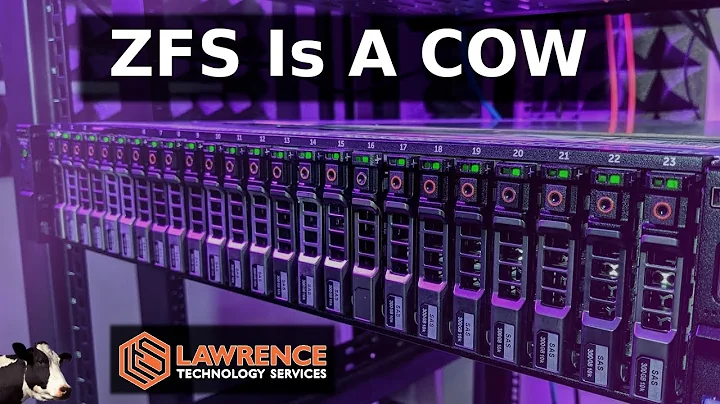Determine if zfs is the actual filesystem
mount -p will show you the file system type used for each mounted file system, eg:
$ mount -p
rpool/ROOT/solaris - / zfs - no
/devices - /devices devfs - no
/dev - /dev dev - no
ctfs - /system/contract ctfs - no
proc - /proc proc - no
mnttab - /etc/mnttab mntfs - no
...
Unless you are currently using a bootable DVD or USB thumbdrive (i.e. you are in the process of installing Solaris from a live media), the root filesystem cannot be but ZFS with Solaris 11. You can't install Solaris 11 and newer on UFS but of course, you can later create and mount UFS file systems.
The /etc/default/fs file doesn't tell what the root file system is but what some commands like mount and fsck will pick as default file system if not specified in the parameters. As ZFS doesn't make use of fsck and very rarely need mount, UFS has been kept here.
Related videos on Youtube
BowPark
Updated on September 18, 2022Comments
-
BowPark over 1 year
With Solaris 11 the default filesystem should be zfs, but following the official guide I obtained (with
cat /etc/default/fs)LOCAL=ufsIs this an error? I thought that the same information was in the output of the
mountcommand, but it wasn't. It is just a list of all the mountpoints.With
mount -pinstead:rpool/ROOT/GUI - / zfs - no /devices - /devices devfs - no /dev - /dev dev - no ctfs - /system/contract ctfs - no proc - /proc proc - no mnttab - /etc/mnttab mntfs - no swap - /system/volatile tmpfs - no xattr objfs - /system/object objfs - no sharefs - /etc/dfs/sharetab sharefs - no /usr/lib/libc/libc_hwcap1.so.1 - /lib/libc.so.1 lofs - no fd - /dev/fd fd - no rw rpool/ROOT/GUI/var - /var zfs - no rw,devices,setuid,nonbmand,exec,rstchown,xattr,atime swap - /tmp tmpfs - no xattr rpool/VARSHARE - /var/share zfs - no rw,devices,setuid,nonbmand,exec,rstchown,xattr,atime rpool/export - /export zfs - no rw,devices,setuid,nonbmand,exec,rstchown,xattr,atime rpool/export/home - /export/home zfs - no rw,devices,setuid,nonbmand,exec,rstchown,xattr,atime rpool/export/home/user - /export/home/user zfs - no rw,devices,setuid,nonbmand,exec,rstchown,xattr,atime rpool - /rpool zfs - no rw,devices,setuid,nonbmand,exec,rstchown,xattr,atime rpool/VARSHARE/zones - /system/zones zfs - no rw,devices,setuid,nonbmand,exec,rstchown,xattr,atime rpool/VARSHARE/pkg - /var/share/pkg zfs - no rw,devices,setuid,nonbmand,exec,rstchown,xattr,atime rpool/VARSHARE/pkg/repositories - /var/share/pkg/repositories zfs - no rw,devices,setuid,nonbmand,exec,rstchown,xattr,atimeIt shows that the root filesystem has zfs. Also with
zfs listI obtainNAME USED AVAIL REFER MOUNTPOINT rpool 7,09G 42,1G 4,65M /rpool rpool/ROOT 4,97G 42,1G 31K legacy rpool/ROOT/GUI 4,96G 42,1G 4,40G / rpool/ROOT/GUI/var 462M 42,1G 231M /var rpool/ROOT/solaris 9,97M 42,1G 2,42G / rpool/ROOT/solaris/var 570K 42,1G 305M /var rpool/VARSHARE 2,53M 42,1G 2,44M /var/share rpool/VARSHARE/pkg 63K 42,1G 32K /var/share/pkg rpool/VARSHARE/pkg/repositories 31K 42,1G 31K /var/share/pkg/repositories rpool/VARSHARE/zones 31K 42,1G 31K /system/zones rpool/dump 1,03G 42,2G 1,00G - rpool/export 49,4M 42,1G 32K /export rpool/export/home 49,4M 42,1G 32K /export/home rpool/export/home/user 49,3M 42,1G 49,3M /export/home/user rpool/swap 1,03G 42,2G 1,00G -So what is the right way to determine the actual filesystem?
-
 Matej Vrzala M4 over 9 yearsDo you have
Matej Vrzala M4 over 9 yearsDo you havediskutilprogram? -
 jlliagre over 9 yearsCan you post the mount output that confuses you ?
jlliagre over 9 yearsCan you post the mount output that confuses you ? -
 Bratchley over 9 yearsAgreed. If you're going to make reference to something, it's best practice to actually let us see what you're talking about.
Bratchley over 9 yearsAgreed. If you're going to make reference to something, it's best practice to actually let us see what you're talking about. -
BowPark over 9 years@ryekayo No, I don't have that program installed.
-
BowPark over 9 yearsSorry, I made a mistake: the output of
mountis just a list of each mount point. It is the output ofcat /etc/default/fsthat is confusing. I will edit my question.
-
-
 Warwick over 9 yearsAlso could use
Warwick over 9 yearsAlso could usezfs listto show allZFSfile systems and their mount points. I like the output frommount -pthough. That is pretty clear. -
BowPark over 9 yearsSorry, can you rewrite your statement? I installed Solaris from a bootable DVD: in this case the filesystem can be only zfs of could also be ufs?
-
 jlliagre over 9 yearsAnswer edited to clarify.
jlliagre over 9 yearsAnswer edited to clarify.




